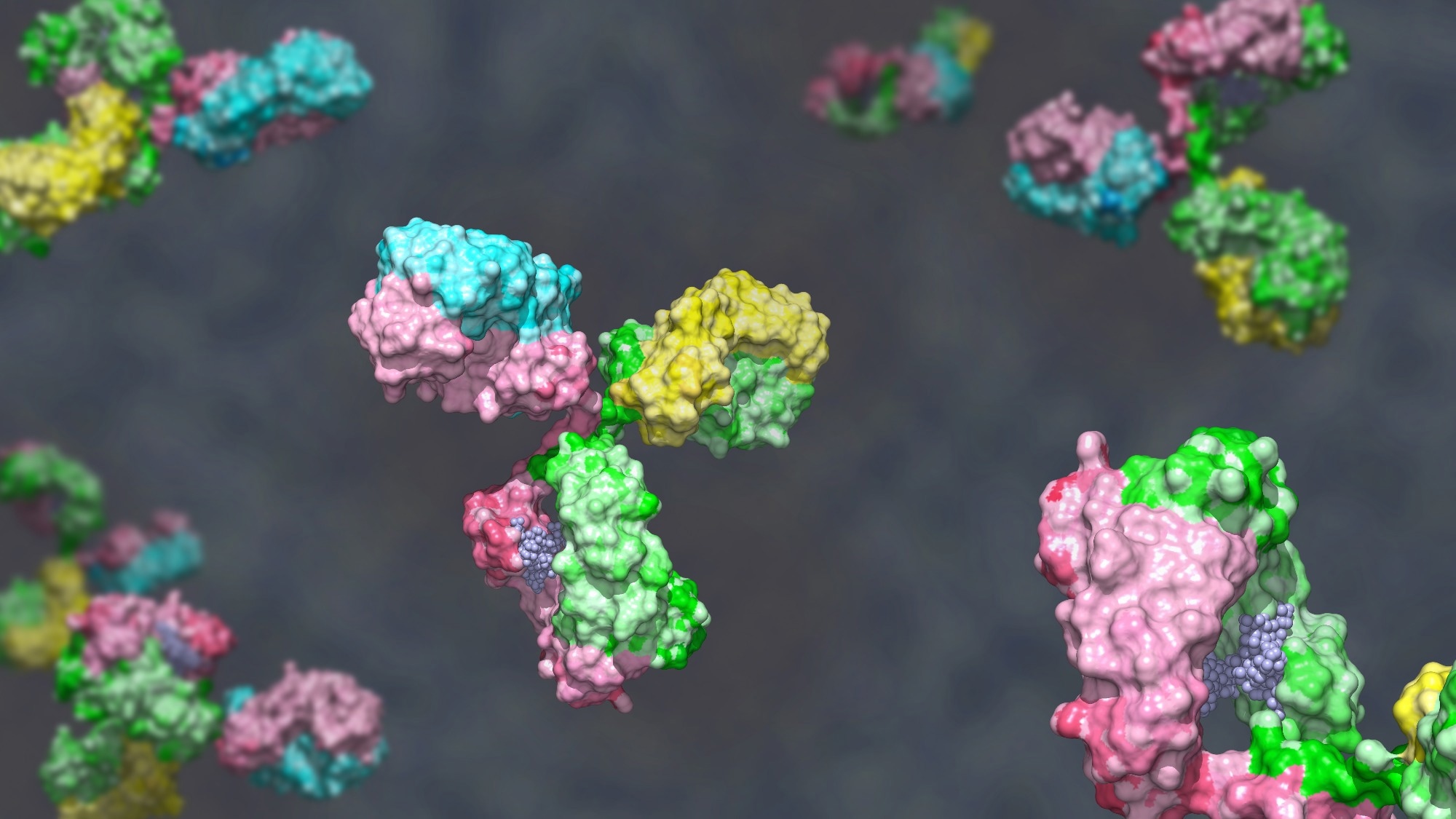In a recent study posted to the bioRxiv* preprint server, researchers at The University of Texas MD Anderson Cancer Center developed fully human bispecific antibodies that bind to two different epitopes of the receptor binding domain (RBD) of the severe acute respiratory syndrome coronavirus 2 (SARS-CoV-2) spike protein and neutralize a wide range of variants including the Omicron variant.
 Study: Development of Fully Human, Bispecific Antibodies that Effectively Block Omicron Variant Pseudovirus Infections. Image Credit: Huen Structure Bio / Shutterstock
Study: Development of Fully Human, Bispecific Antibodies that Effectively Block Omicron Variant Pseudovirus Infections. Image Credit: Huen Structure Bio / Shutterstock

 *Important notice: bioRxiv publishes preliminary scientific reports that are not peer-reviewed and, therefore, should not be regarded as conclusive, guide clinical practice/health-related behavior, or treated as established information.
*Important notice: bioRxiv publishes preliminary scientific reports that are not peer-reviewed and, therefore, should not be regarded as conclusive, guide clinical practice/health-related behavior, or treated as established information.
Background
SARS-CoV-2 is an enveloped, single-stranded ribonucleic acid (RNA) virus that enters the mammalian host cells through interactions between the RBD in the S1 subunit of the spike protein and angiotensin-converting enzyme-2 (ACE-2) receptor in the mammalian cell. Transmembrane serine protease 2 (TMPRSS2) present in the mammalian cell aid the viral entry by cleaving the spike protein.
The accumulation of mutations in SARS-CoV-2 has led to the emergence of multiple variants such as Alpha, Beta, Delta, and Omicron, with Omicron and its subvariants carrying the largest number of novel mutations. These mutations in the spike protein region have enabled the Omicron subvariants to evade the neutralizing antibodies induced by coronavirus disease 2019 (COVID-19) vaccines as well as the monoclonal antibodies that have, thus far, been successfully used to treat infections from previous variants.
Although cocktails of monoclonal antibodies continue to be relatively effective against the Omicron subvariants, bispecific monoclonal antibodies that simultaneously bind to two independent epitopes on the virus present a more time and cost-effective solution that needs to be explored further.
About the study
The present study used single B cell cloning and humanized transgenic mice to generate monoclonal antibodies that could bind and neutralize multiple SARS-CoV-2 variants. Female ATX-GK mice were immunized subcutaneously with spike protein dissolved in phosphate-buffered saline along with an adjuvant and administered one booster shot every week for three weeks. Three days after the third booster dose, an additional booster dose was administered intraperitoneally, and the mice were euthanized four days after the last booster dose. Bone marrow, spleen, blood, and draining lymph nodes were harvested to obtain antibodies.
Memory B cells from alloy humanized transgenic mice were used to amplify the variable heavy and light chains using a single B-cell closing technology. Two antibody clones that recognize different spike protein epitopes were selected to produce the bispecific monoclonal antibodies. Micro-scale transfection using a single expression vector expressed in the ovary cells of Chinese hamsters was used for the high-throughput production of monoclonal antibodies.
Fast protein liquid chromatography was used to purify antibodies from the culture supernatant, which were quantified using a NanoDrop, and the concentration of the monoclonal antibodies was calculated. Additionally, horseradish peroxidase (HRP)-conjugated horse anti-monoclonal Immunoglobulin G (mIgG) was used to detect the titers of SARS-CoV-2-specific antibodies, and bio-layer interferometry (BLI) assay was employed to screen for anti-SARS-CoV-2 monoclonal antibodies. Furthermore, ACE-2-blockage assays and pseudovirus assays were conducted to test if the monoclonal antibodies could effectively bind to the virus and block the binding of the ACE-2 receptor.
Results
The results reported that the two selected monoclonal antibodies — SARS-CoV2-83 and SARS-CoV2-81 — were able to bind to multiple SARS-CoV-2 variants, including the Omicron variant with moderate to strong affinities. The two monoclonal antibodies were not, however, able to bind to one of the mutants (L452R) of the Delta variant. The bispecific antibodies designed by combining the heavy or light chains of SARS-CoV2-81 with the single chain variable fragment of SARS-CoV2-83 were able to bind to all the variants of SARS-CoV-2 that were tested, including the Delta variant L452R mutant.
Furthermore, the bispecific antibodies expressed higher avidity binding to the RBD of the Omicron variant than that expressed by the two monoclonal antibodies independently. One of the bispecific antibodies (Bs-A) was also able to neutralize the Omicron pseudovirus in the in vitro assay. These findings indicated that the bispecific antibodies expressed increased avidity during binding and greater neutralizing ability as compared to the two parent monoclonal antibodies.
Conclusions
Overall, the results indicated that the fully human, bispecific monoclonal antibodies developed using two novel monoclonal antibodies SARS-CoV2-83 and SARS-CoV2-81 showed high-avidity binding and neutralizing of multiple SARS-CoV-2 variants, including the Omicron variant. The avidity of SARS-CoV2-81 was also found to be comparable to currently used Sotrovimab, manufactured by GSK, indicating that it could be a potential monoclonal antibody candidate for clinical use.
The authors believe that while bispecific antibodies are effective against multiple SARS-CoV-2 variants, the rapid emergence of new variants challenges the efficacy of these antibody therapies, emphasizing the continued need for the development of broadly neutralizing bispecific antibodies that target different epitopes.

 *Important notice: bioRxiv publishes preliminary scientific reports that are not peer-reviewed and, therefore, should not be regarded as conclusive, guide clinical practice/health-related behavior, or treated as established information.
*Important notice: bioRxiv publishes preliminary scientific reports that are not peer-reviewed and, therefore, should not be regarded as conclusive, guide clinical practice/health-related behavior, or treated as established information.
Journal reference:
- Preliminary scientific report.
Development of Fully Human, Bispecific Antibodies that Effectively Block Omicron Variant Pseudovirus Infections: Jason K Allen, Michelle A Gonzalez, Jasbir Kaur, Melinda Smith, Junping You, Guojun Yang, Dongxing Zha, Ze Tian, Amin Al-Shami, Chunhua Shi, Jeffrey J Molldrem, and Tim Heffernan. bioRxiv. 2023, DOI: https://doi.org/10.1101/2023.03.07.531527, https://www.biorxiv.org/content/10.1101/2023.03.07.531527v1